Well water with a low pH, or acidic water, poses a whole host of problems around the home, including corrosion and metal contamination.
Acidic water can be caused by a lack of calcium, dissolved carbon dioxide, or industrial or mining runoff in the local area.
To raise the pH of your well water, install an acid neutralizing water filter with a pH-boosting media (like calcite). or inject soda ash into your water with a chemical feed pump.
For a detailed explanation of how to raise well water pH, read on.
Table of Contents
🔔 Indications of Low pH
The indications of low pH are plumbing leaking, red rust stain or blue-green stains, and corrosion on the piping inside your toilet tank.
Plumbing Leaks
Acidic water can corrode the inside of your pipes and plumbing over time. As these surfaces are worn away, the likelihood of pinhole leaks increases. You may also notice cracking and stress on the outside of your pipes.
A leak doesn’t have to be huge to cause a problem. Small, 10-drops-per-minute leaks typically waste nearly 3 liters of water per day. A small leak can also turn into something much larger if the pipe continues to be corroded by acid water.
Red Rust Stains on Galvanized Iron Plumbing
If your home has galvanized plumbing, you’ll likely notice rust-like, red stains on affected surfaces. When the inside of this plumbing corrodes, your water will also take on a reddish-brown shade as a result, and it may have a metallic taste.
Rusty water isn’t usually dangerous, but it’s a clear sign that you need to treat your water’s acidic imbalance before the situation gets any worse.
Blue-green Stains on Copper Plumbing
If you have copper pipes in your home, blue-green staining on your fixtures, faucets and plumbing is an indicator of water with a pH of lower than 6. You may also notice discoloration of your water and an unpleasant taste. Corrosion of copper pipes can even affect your hair color.
You’re most likely to notice signs of copper corrosion on your aluminum fixtures, such as the drain in your bathroom sink. If copper leaches from your pipes into your water, it could also cause health problems.
Corrosion on Piping Inside Toilet Tank
Rust and corrosion on the inside of your toilet tank can build up and eventually cause your toilet to decay. This is another common indication of acid water. You may also see corrosion inside your toilet bowl.
Resolving your water pH issue is unavoidable if you want your toilet to live past the next few years, but in the short term, cleaning the rust as quickly as possible should prevent a build-up.
🧪 How to Test Water pH
If you don’t currently know your water’s pH level, that’s the place to start.
The pH scale ranges from 0 to 14. Water with a pH level of less than 7 is acidic. A pH of 7 is neutral, while anything above 7 is alkaline.
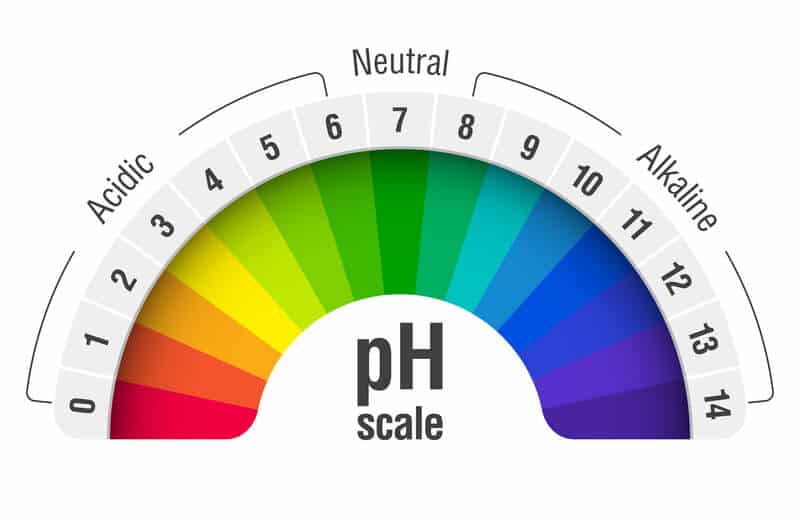
The simplest way to test your well water is to use an at-home testing kit. Most pH tests simply require dipping a test strip in a sample of your water. The strip will change color, and you can compare the color to a chart to determine your pH.
The more precise pH test option is to get your water tested by a laboratory. Laboratory testing will give you an accurate insight into where your water is on the pH scale. Home testing kits, on the other hand, may only give you a vague indication.

😣 Problems Caused by Acidic Water
Corrosion
The biggest problem with acidic water is the damage it causes to the plumbing in your house.
Acidic water causes corrosion – the breakdown of materials over time. When your pipes start to dissolve, they’re more susceptible to leaking. The metals from these pipes will also break off and enter your drinking water.
Metal Leaching
Another major concern about acid water is that it’s more likely to contain high amounts of heavy metals.
According to research, acidic solutions are more susceptible to incur metal leaching. Water with a low pH is lacking in minerals, and grabs anything it can find on its journey to your faucet to try and increase its pH back to neutral.
As a result, when water travels through your pipes, it’ll pick up metals that you then end up drinking. Some of the heavy metals that may leach into your acid water, based on what the water is exposed to, are:
- Lead
- Copper
- Arsenic
- Nickel
- Zinc
- Chromium
You can find many of these metals around your home, including in your pipes, well pump, and plumbing system.
Exposure to heavy metals can cause a range of health effects, from vomiting and diarrhea to shortness of breath and even organ damage. Drinking acidic water can also damage your teeth and bones.
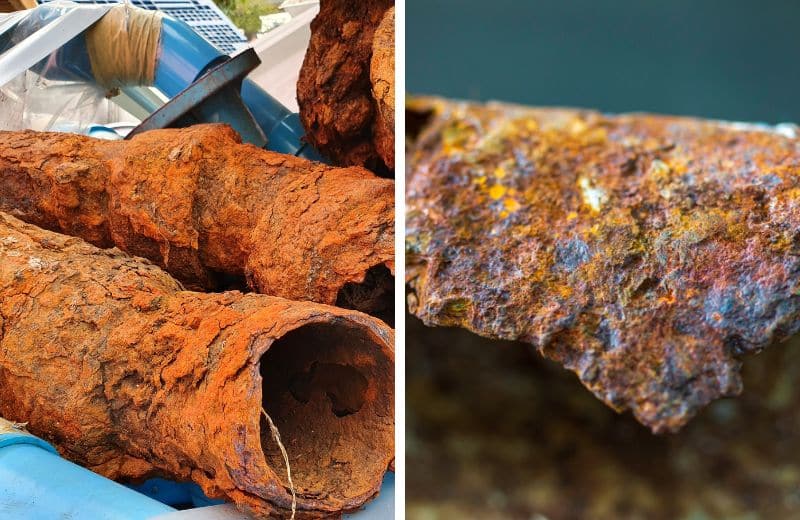
✔️ How to Fix Acidic Well Water
There are two simple remedies to fix acidic well water: acid neutralizer filters and chemical feed pumps.
Acid Neutralizer Filter
Acid neutralizer filters raise the pH of water by treating it with a pH-boosting media.
Typically, a neutralizing system will use a calcium carbonate media (known as calcite) or a blend of calcium carbonate and magnesium oxide (otherwise called corsex).
The most common system consists of a single media tank and a control head. When acid water flows through the tank, some of the media inside the tank dissolves into the water.
This results in water with a pH of around 7 to 7.5, depending on the original pH level.
Acid neutralizer filters will usually require backwashing to maintain a high level of operation. When water flows through the tank, it tends to take the same routes every time. This means that certain parts of the calcite media will be used before others.
Backwashing sends water through the tank in the opposite direction, causing the calcite media to spin around. When backwashing finishes, the media has settled in a new position. Still, this media will run out eventually, and you’ll have to top it up every 6-12 months.
It’s important to buy the right sized tank for your neutralizer filter based on your water flow rate. These water systems can affect the performance of your home’s appliances and the flow of water through your plumbing fixtures if sized incorrectly.
The majority of neutralizing filters are installed at your home’s point of entry. This means they won’t protect your well itself, including the pressure tank and the well pump. You may be able to buy components that have protective linings or coatings to reduce the risk of acid damage in your well.
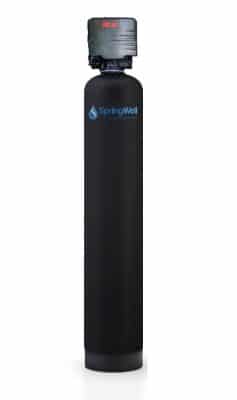
Calcite Media
An acid neutralizer that uses calcite media can treat water with a pH level of 6 to 6.5. This acidic water treatment material is made from crushed white marble.
When water is treated with calcium carbonate, its pH will be boosted. This works in the same way that it would in the natural environment, if water was to flow through a calcium-rich rock.
Usually, a neutralizing filter will come with a batch of calcite media as part of the initial price. You can buy replacement calcite media online.
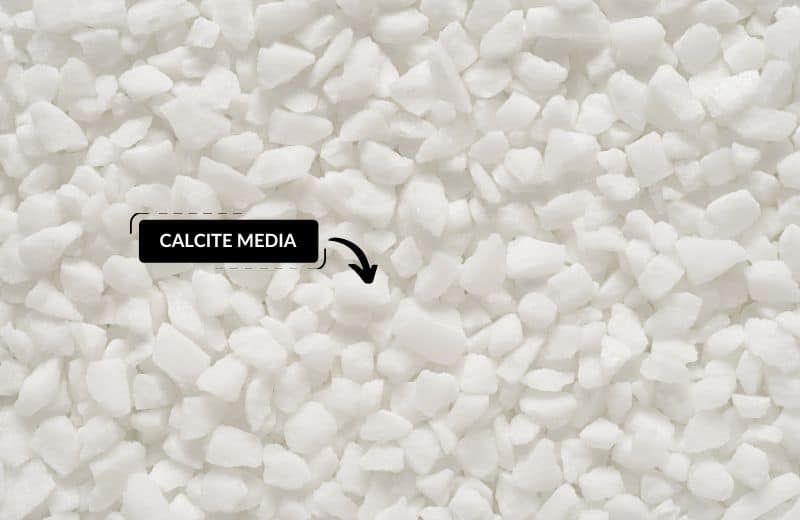
Calcite-Corosex Blend Media
While calcite media is suitable in most circumstances, you may be dealing with acid water with a pH of even lower than 6. While calcite media can typically increase the pH of water by 1, magnesium oxide and corosex used together can increase pH by up to 1.5.
When using calcite and corosex together, you should be adding roughly 10%-20% magnesium oxide and 80%-90% calcite media.
❗️ Be wary of adding too much corosex, as it may raise the pH of the water too high.
A high pH poses its own problems. Magnesium oxide can also have a laxative effect, so use it sparingly.
One thing to keep in mind about using calcite and magnesium oxide as an acidic water treatment remedy is that it will boost your hardness minerals (calcium and magnesium).
Calcium and magnesium minerals form scale, which can be damaging to your pipes. You don’t want to swap one water quality issue for another, so you may need to consider buying a whole-house water softener to soften your water after calcite-corosex treatment.
Chemical Feed Pumps
For water with a particularly low pH of 4 or 5, the only suitable remedy is soda ash injection via a chemical feed pump.
Chemical feed pump systems treat acidic water by injecting the right amount of soda ash to raise its pH to neutral. An injection system consists of a chemical feed pump and a tank. The control valve is programmed to inject the suitable level of soda ash needed based on your water quality.
A chemical injection system requires electricity to inject the soda ash solution into the water. Sodium hydroxide may also be used in place of soda ash.
An advantage of this type of pH water treatment is that it won’t cause any hardness problems in treated water. This system is also unaffected by flow rate.
Chemical feed pumps also don’t require a backwash cycle and don’t waste any water during the treatment process.
An injection system is installed at your home’s point of entry. However, these water systems don’t just protect your home’s pipes and appliances. They will feed soda ash solution directly into your well itself, which will protect the pump and casing from corrosion.
Maintenance for chemical feed pumps is minimal. You will need to refill the soda ash storage tank and periodically clean the screens. The pump itself will also require cleaning and maintenance from time to time.
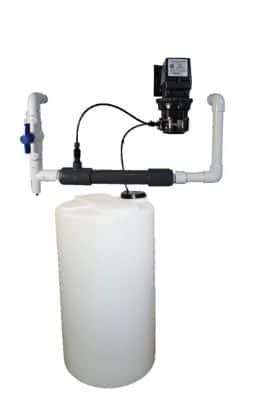
❔ Frequently Asked Questions
Why is my well water acidic?
Drinking water pH can be affected by chemicals and mineral ions in the water supply. In the US, you’re most likely to find acidic water in Oregon, Northern Wisconsin, New York, and Colorado Mountains.
Usually, an imbalance in soil or bedrock results in acid water. Rainfall is relatively acidic, but when it lands on the ground, it will usually collect minerals from the surfaces it comes into contact with.
However, some rocks, including granite and igneous rocks, have a low calcium content. This means that the water’s pH won’t be raised to neutral before it enters the aquifer.
Another reason for acidic drinking water is chemical run-off from agricultural and industrial processes. Carbon dioxide from plant decomposition may also alter pH and increase acid levels.
Is acidic well water safe to drink?
It depends on how acidic the water is, and the metal contaminants it is exposed to.
Acid water that contains metal ions like copper, lead and arsenic can cause a number of health issues, depending on the concentration of the metals in your drinking water.
Other health risks of drinking water with a low pH include damage to your tooth enamel and a lack of calcium absorption in the body, leading to bone loss.
Generally, drinking acidic water shouldn’t pose a serious threat to your health. In any case, it’s best to treat acid drinking water to protect your home and your health.
What is the average pH of well water?
Most surface water wells have a pH range of 6.5 to 8.5. Groundwater systems have an average pH range of 6 to 8.5.
Remember that this is just the average pH, and your well water may not reflect this figure. The region that you live in will play a part in how acid or alkaline your water is. It’s a good idea to test your water to determine its exact pH, rather than guessing. You may also be able to source information about your local water’s pH online.
Is there a problem with high pH?
You might think that the higher the pH, the better, when it comes to the quality of your drinking water. But actually, alkaline water can be just as detrimental to your home and health as acid water.
While acid water doesn’t carry enough mineral ions, water with a high alkalinity carries too much. This can cause scale on your pipes and plumbing fixtures. As a result, you may experience issues with your water flow rate, and your water heaters and other appliances may lose efficiency. High pH water can even shorten the lifespan of these appliances.
You will need to employ a water treatment solution to lower the pH of your drinking water.
Can acid neutralizers or soda ash injection systems also filter water?
No. Acid neutralizers that use corosex may be able to remove a small amount of iron, but for general filtration, you’ll need to install a whole home filter system alongside your neutralizing system. Remember, acidic water is more susceptible to contamination, so it’s wise to test and treat your water appropriately.
An advantage of a soda ash injection system is that you can use it to disinfect your water and alter it’s pH. As well as the neutralizing chemical, you can add chlorine to your system, and the unit will do two important jobs at once.
